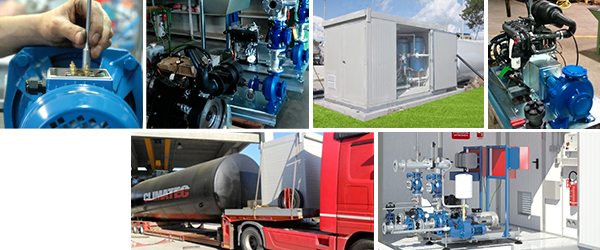Climatec is the exclusive distributor for Highberg tanks in Italy: large-volume reserves for storing liquids such as water (potable, industrial, firefighting, irrigation, effluent), oil and fuels, chemicals, liquid biomass, and leachate.
Highberg Tanks S.C. Highberg Solution Srl has been in the large tank market for ten years. It originated in Romania and expanded into Europe and the Middle East.
The company's design department has designed and calculated tank structures to ensure high performance in any location and environment.
Highberg Solution adheres to the strictest international criteria for design, production, and assembly, including FM Approved, NFPA, VdS, WRAS, ISO9001, ISO14001, and ISO18001, OHSAA 18001, UKAS, and LPCB. Each tank is designed according to AWWA (American Water Works Association) D103-09, API12B (American Petroleum Institute), VdS CEA 4001:2014-04, or FM4020.
GALVANIZED STEEL AND STAINLESS STEEL TANKS
TECHNICAL FEATURES
Galvanized steel and stainless steel tanks are produced according to BS EN 10147 Grade Fe E350G standards. They are available in circular or rectangular sections.
Galvanized steel panels are made with a zinc coating of 600 g/m2, which protects against corrosion, bolted joints, and the structure is reinforced with diagonal struts with static and dynamic calculation, depending on the installation location.
Tank body sealing is made with a synthetic coating in BUTILIC/EPDM/XRS, which separates the stored liquid from the tank coating, thus preventing tank corrosion. The membrane is protected from mechanical and non-mechanical perforations, equipped with 10mm thickness and 45 gr/cm3 compact geotextile felt. This type of coating is suitable for various types of liquids.
The liner ensures complete water isolation due to high-density molecular structures that prevent the interposition of liquids or vapors. Furthermore, this type of coating is not altered by weather conditions and maintains well over time. The internal coating is prefabricated to adapt to any tank size and shape.
Tanks are equipped with a complete hydraulic system, made of D304 stainless steel: connection nozzles, fixing brackets for internal pipes, etc.
Thermal insulation is provided by polystyrene panels, density of 200 kg/m3, according to thermal transfer calculation from the installation area. These panels are used and fixed between galvanized steel sheet panels and the coating, through special clamps. The coating fixation on the tank edge and also the seal roof prevent liquids from coming into contact with the insulation.
Tank insulation can be made external with mineral wool and protected with corrugated sheet metal. In this case, the internal coating can be eliminated. Thus, the stored liquid will come into contact with the tank body.
There is an immersion heating system for thawing water below 3 degrees Celsius.
The roofs, designed and calculated according to the site and the type of stored liquid, are available in various solutions. They are all made of composite aluminum panels (sandwich panels), 50 mm thick, built and assembled according to international standards. They have an incorporated gate and ventilation system. Roofs are available in four versions: terrace roof, conical roof, dome roof, or roofless.
These tanks are produced and designed to be optimally used in any location and environment. In fact, they are tested at -42 degrees Celsius for 6 consecutive days.
USE AND ADVANTAGES
Highberg galvanized and stainless steel tanks are extremely versatile; they can store various types of liquids, such as:
potable water,
process/technical water,
irrigation water,
firefighting water reserves for sprinkler systems,
wastewater from wastewater treatment plants,
diesel and oil sludge,
industrial oils, and other hydrocarbon-based liquids.
They are much cheaper than traditional concrete tanks. Installation is simple and fast, maximum five days for the largest tanks. No sealant is needed for the assembly of vertical cylindrical tanks. The "top&down" system with hydraulic jacks is used.
They have a long lifespan: in urban environments up to 72 years, 95 in rural areas, 55 in industrial areas, at sea, or in harsh industrial environments 40 years. They have almost nonexistent maintenance costs, both for the interior and the exterior.
They can be installed in small spaces, it's very easy and economical to increase their capacity, and they can be dismantled and reassembled elsewhere.
FIBERGLASS COATED STEEL TANKS
TECHNICAL FEATURES
Fiberglass-coated steel tanks are modular, available in various sizes with capacities ranging from 50 m3 to 25000 m3. The design is customizable according to customer requests.
The roof has a rigid structure, consisting of lightweight polyurethane panels positioned on a galvanized steel beam structure with a "Z" section S350GD Z275 according to SR EN 10147:2001 and SR EN 10143:2001. The polyurethane panels are mounted in a "z" to ensure roof tightness. This assembly ensures that water is not contaminated by dust or other impurities. There are four different options for the roof: flat, conical, dome, or roofless.
The upper edge of the tank is protected with a galvanized sheet metal angular profile. Additionally, each roof is structured based on the site's climatic characteristics. External insulation is made of mineral wool and corrugated sheet metal. As for internal insulation, it is made of polystyrene panels with a thickness of 50 mm, fixed between fiberglass-coated steel panels and the coating. Since the latter is fixed to the tank's edge and the roof is sealed, water cannot interfere with the insulation.
USE AND ADVANTAGES
Maintenance costs are almost negligible, also because the liner can be removed. A fiberglass tank is not painted and therefore does not require that type of maintenance. Furthermore, fiberglass withstands time without the need for interventions. Construction is fast and with very low environmental impact.
These types of tanks are ideal for storing: potable water, wastewater, process water, biodigesters, and anaerobic biodigesters.



